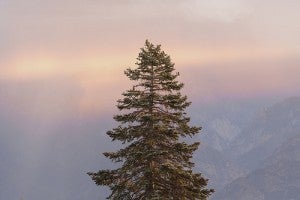
On June 22, the Forest Service announced that there is a record 66 million dead trees in the southern Sierra Nevada. Credit: Kings Canyon National Park, California (license)
Scientists from the U.S. Forest Service estimate that as many as 26 million trees have died in the Sierra Nevada over the last eight months, creating a landscape at risk for massive wildfires.
Sierra Nevada forests require fire to maintain ecological integrity and periodic fires create patches of complexity that actually enhance biodiversity and ecosystem integrity. But tree mortality at this level creates an immediate risk to human communities and plant communities.
Why are trees dying?
Changes in weather that stress trees or exacerbate other stressors like bark beetle infestations are driving the current wave of tree mortality. Temperatures are increasing at a faster rate at higher elevations and precipitation patterns are changing. Specifically, more precipitation is falling as rain and less as snow, which leads to faster runoff and less percolation into the soil. And despite a relatively wet winter, California is still locked into its fifth year of drought.
These dynamics have been particularly acute in the southern Sierra Nevada, where precipitation continues to be below normal. Tree mortality is highest in the southern part of the range as seen in this map.
So what can we do about this? Read More









